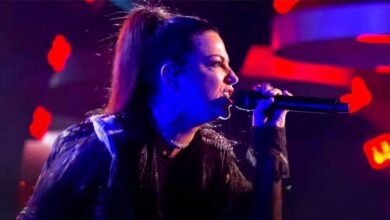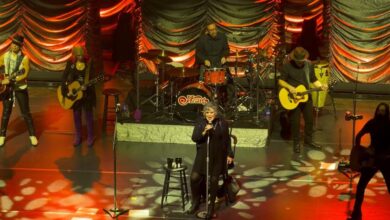Disturbed’s Spellbinding Conan Performance Transforms “The Sound of Silence” Into a Timeless and Haunting Masterpiece for a New Generation
When March 2016 rolled around, few could have foreseen that one of heavy metal’s fiercest bands would trade ferocity for reflection. On March 28, Disturbed took to the stage on Late Night with Conan O’Brien and revealed a version of themselves that stunned the world. Their haunting delivery of Simon & Garfunkel’s “The Sound of Silence” brought the audience to complete stillness. This was no ordinary cover—it was a moment of reckoning, where fragility met strength, redefining how fans perceived the emotional depth of the band forever.
The crowd gathered that evening expected the familiar roar of guitars and the pounding of drums, but what they experienced was the opposite—tranquility. The stage lights softened to a quiet hue, casting the room in warmth rather than chaos. When David Draiman’s baritone voice broke the silence, rich and resonant, the atmosphere shifted instantly. Each syllable hung in the air, delicate yet forceful, as if every note confessed something deeply personal. The audience’s silence became part of the performance itself, an unspoken agreement of reverence and awe.
That performance connected generations in a way no one expected. Among those who saw the broadcast was Paul Simon himself, who found the rendition so moving that he reached out to Draiman days later. In an email dated April 1, 2016, Simon described the cover as “emotionally powerful and deeply stirring.” That message bridged decades of musical history—a quiet acknowledgment from one artist to another that true expression knows no boundaries of genre or time. It was the passing of a torch, not through sound, but through shared humanity.
Draiman’s reply reflected both humility and gratitude. He described Simon’s note as one of the greatest honors of his life and reiterated that Disturbed’s intent had never been to compete with the original but to honor its soul. This respectful exchange transformed the moment into something transcendent—a dialogue between eras, between folk sincerity and metal intensity. It reminded the world that at its core, music is about emotion, and emotion is universal. Disturbed’s reinterpretation didn’t just echo Simon’s message—it reawakened it for a new age.
The band had quietly introduced the cover months earlier on their sixth studio album, Immortalized, released in August 2015. Among aggressive anthems and thunderous riffs, “The Sound of Silence” stood out like a single candle in the dark. Its restraint made it magnetic. Listeners responded instantly, propelling it up the charts. The song reached number 42 on the Billboard Hot 100 and claimed the top spot on both the Hard Rock Digital and Mainstream Rock charts. A song born from reflection had unexpectedly become the band’s defining statement.
When the single dropped in December 2015, fans realized they were hearing an entirely new side of Disturbed. Dan Donegan’s delicate interplay between acoustic and electric tones framed Draiman’s haunting voice with cathedral-like depth. Mike Wengren’s drumming, stripped of aggression, carried a heartbeat of control rather than force. The production shimmered with cinematic weight—every note deliberate, every pause intentional. The track was not designed to dominate but to envelop, proving that true power doesn’t always roar; sometimes it breathes.
Translating that sound onto Conan’s stage turned reverence into revelation. The usual buzz of late-night television fell away the moment the first chord rang out. Draiman’s performance moved between gentle intimacy and commanding intensity, creating waves of emotion that rippled through the audience. Viewers watching from home described chills that refused to fade. In that brief span of minutes, the performance became more than entertainment—it was spiritual. Silence, once merely absence, became the centerpiece of expression itself.
The aftermath was explosive. Critics debated its theatrical nature, but none could deny its sincerity. Disturbed had set aside the armor of distortion to reveal raw vulnerability. The performance wasn’t about shock—it was about honesty. In an age of irony, their emotional openness felt revolutionary. Fans who once turned to the band for rage now found solace. It proved that in music, authenticity cuts deeper than any scream. They had discovered a new weapon: empathy.
The song’s reach expanded like wildfire across the internet. By 2017, “The Sound of Silence” had sold over 1.5 million digital copies and amassed hundreds of millions of streams. Its official video surpassed one billion views, while the Conan performance itself became the show’s most-watched segment ever, with over 150 million plays. What began as a quiet experiment in restraint had evolved into a cultural landmark—an emotional event shared across generations, transcending genre and language alike.
Its impact came from contrast—the collision of fury and stillness, of rebellion softened into grace. The performance united the introspective tone of the 1960s with the emotional intensity of modern rock. Rather than reinterpreting the song as defiance, Disturbed delivered it as devotion. Each word sounded sacred, every silence meaningful. It was a meditation disguised as a metal ballad, reminding listeners that stillness can shake the soul as powerfully as sound.
For Disturbed, that night became a rebirth. After a four-year hiatus, Immortalized had already proven their return, debuting atop the Billboard 200. Yet “The Sound of Silence” went further—it redefined them. It showed that strength doesn’t always mean aggression; it can also mean honesty. Through one quiet performance, they found a new identity: not conquerors, but connectors. Their legacy would now include not just noise, but nuance.
Producer Kevin Churko played a pivotal role in crafting that transformation. His vision replaced distortion with orchestration, aggression with atmosphere, and chaos with clarity. Strings weaved through the arrangement, adding cinematic weight without overwhelming the emotion. The production blurred the lines between genres, marrying metal’s intensity with classical elegance. Churko didn’t just polish the sound—he built a space where emotion could breathe, where silence itself became part of the music.
Recognition soon followed. In 2017, the song earned a Grammy nomination for Best Rock Performance, solidifying its place as a modern classic. But for the band, the accolade meant more than prestige—it symbolized courage. “The Sound of Silence” had begun as an artistic gamble and ended as validation that evolution is not betrayal. By stepping into unfamiliar territory, Disturbed had proven that true artistry requires risk—and that vulnerability can be louder than rage.
Those lucky enough to witness the Conan performance still speak of it in reverent tones. They remember expecting chaos and receiving calm instead. The tension between expectation and reality created something extraordinary. When the final note faded, the applause wasn’t wild but sacred, a release of emotion too large for words. It wasn’t about volume—it was about presence. For once, silence didn’t follow the song; it became part of it.
That performance didn’t just shift Disturbed’s direction—it changed the conversation about what modern rock could be. The song united fans from every background, transforming isolation into communion. Viewers wept, strangers shared the same quiet reverence, and the timeless lyrics found new resonance in a restless century. A piece born in the 1960s had been reborn for a world still searching for meaning in the noise. It was history repeating itself—not through rebellion, but through empathy.
Years later, Disturbed’s “The Sound of Silence” still stands as a beacon of artistic courage and emotional authenticity. It transcends the label of a cover, emerging as a complete reinvention. Draiman’s voice didn’t just echo Simon’s words—it redefined them. The performance proved that music’s truest power lies in its ability to unite hearts and awaken souls. In their hands, silence became an anthem—not of emptiness, but of humanity’s enduring need to listen.





